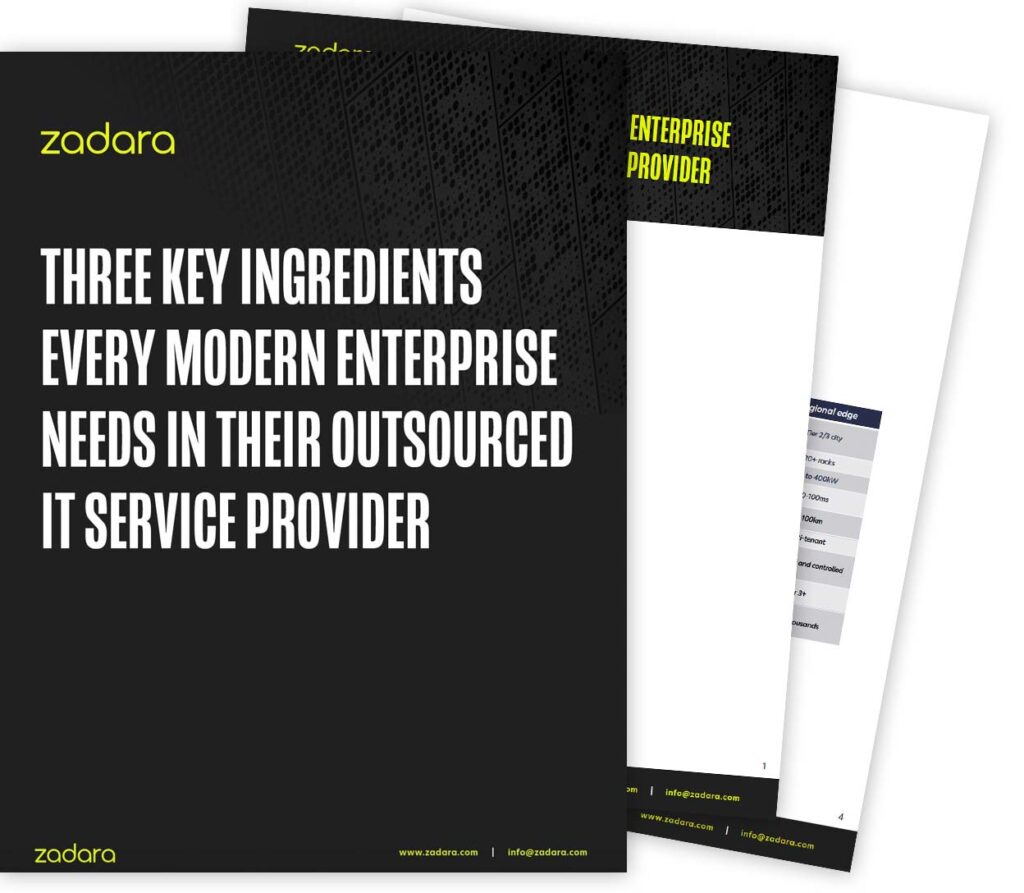Enabling the Datacenter of the Future
The datacenter of the future needs to be similar to the cloud today: a scalable farm of standard x86 servers connected with a single network, with the ability for each user to be able to create Virtual Servers, Virtual Networks and Virtual Storage Arrays.
This article explains how Zadara Virtual Private Storage Arrays™ complete the piece of the datacenter puzzle that had been missing until now.
First, Virtual Servers (VMs)
The datacenter virtualization trend started a few years ago, when VMware and others succeeded in creating a Virtual Machine that was almost identical to a physical server. It took many years until hardware supported this capability in a way that offered similar performance to that of a physical server. Once this was achieved, there was hardly any remaining reason to deploy an application on a dedicated physical server.
In addition to the huge CapEx savings (thanks to the ability to consolidate as many as 10-20 VMs in a single physical server), server virtualization became popular because of the operational agility it introduced into the IT world. Instead of weeks to deploy a new server, it was suddenly possible to deploy in minutes. When a server was not needed anymore, it could be deleted, returning the resources back to the pool, as opposed to storing defunct physical servers in a warehouse.
Then, Virtual Networks (SDN)
After server virtualization became popular, it was clear that the network infrastructure needed the same transformation. VMs could be created easily, but server administrators would need to ask their network counterparts to configure the network. Things got more complicated when a customer wanted to create separate networks for different application servers. Back in the old days of physical servers, it was easy to create separate networks; each set of physical servers would be on different networks. But with virtualization, suddenly the same physical server and NIC can have multiple VMs that potentially need to be on different networks.
The need for network virtualization was further accelerated because of the speed and quantity with which new virtual servers were being created and repurposed. In a cloud environment, either public or private, it is critical to have a single physical pool of hardware resources that can scale and can be configured in a multi-tenant environment; that is, each tenant must feel as if they have a physical network. Nicira and other companies came up with the concept of a Software Defined Network, where it is possible to have a single physical network infrastructure, yet define in software thousands of Virtual Networks, each isolated from all others, and providing each tenant the full control of his or her Virtual Network.
Now, Virtual Private Storage Arrays (VPSA™)
The only piece missing from the fully virtual datacenter is the Virtual Storage Array. Currently, in most datacenters and clouds, storage is served by a single monolithic or scale-out storage system, and in some cases, even with custom hardware. The main problem with monolithic (and even with the new scale-out) storage systems is that they are not multi-tenant. They do not offer performance separation between different tenants, and they do not offer storage management to each tenant. This means that today, each user can create multiple Virtual Machines that look like physical machines, and can have one’s own Virtual Networks that look like physical networks; but on the storage side, one can only get storage capacity in the form of volumes that cannot be managed, with their performance affected by other users. In other words, now is the time for Virtual Storage Arrays to be connected to those Virtual Networks and Virtual Servers.
Zadara Storage pioneered the concept of Virtual Private Storage Arrays (VPSAs) that look, perform, and have the same features as SAN/NAS arrays. They can also be created in minutes by each tenant. These VPSAs run on top of a scalable farm of standard x86 servers, yet provide the same availability as classical storage arrays. By allocating the resources (CPU, memory, network and drive) to each VPSA, multiple tenants can run on the same physical machines without interfering with one another. Also, each tenant has full management of the storage; they can decide on RAID levels, volume allocations, volume presentation as Block or File, snapshot frequency, and even DR strategies — just like they would if they had a physical storage array.
From a data privacy standpoint, Virtual Storage Arrays are isolated for complete security, and each VPSA can be on a different Virtual Network or VLAN.
Zadara Virtual arrays have even more advantages over physical arrays, as they are completely elastic. A user can add, remove and replace drives instantly. And, he or she can upgrade and downgrade the size of the storage controllers without IO interruption.
With Zadara Virtual Private Storage Arrays, the future is now!




